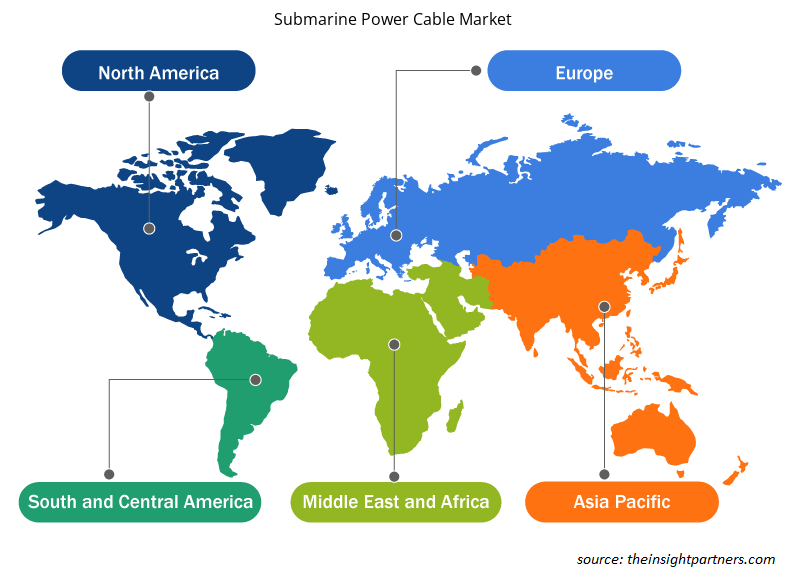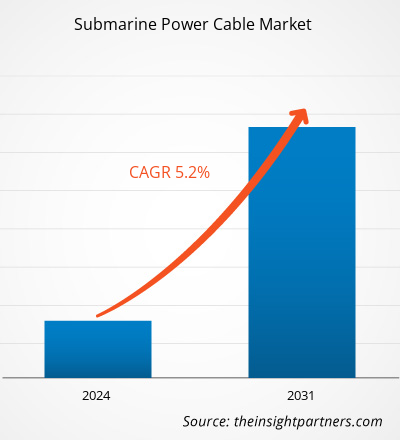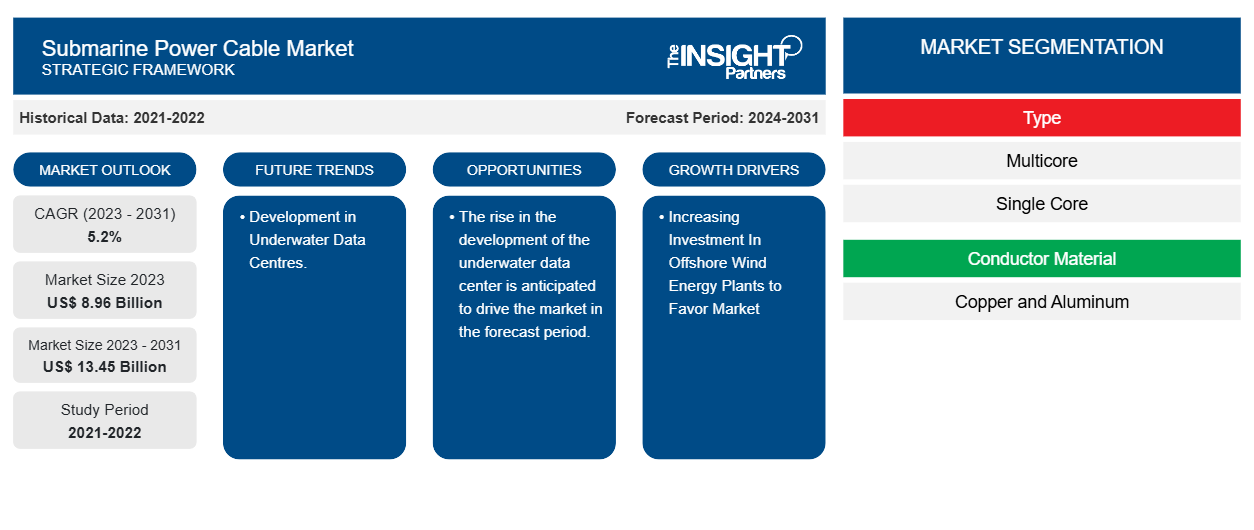Si prevede che la dimensione del mercato dei cavi elettrici sottomarini raggiungerà i 13,45 miliardi di dollari entro il 2031, rispetto agli 8,96 miliardi di dollari del 2023. Si prevede che il mercato registrerà un CAGR del 5,2% nel periodo 2023-2031. I crescenti investimenti negli impianti di energia eolica offshore e l'aumento dei collegamenti sottomarini transnazionali per la trasmissione di energia saranno probabilmente i principali motori e tendenze del mercato.
Analisi di mercato dei cavi di alimentazione sottomarini
Il mercato dei cavi elettrici sottomarini sta vivendo una crescita significativa a livello globale. Questa crescita è attribuita al crescente investimento in impianti di energia eolica offshore e all'aumento delle connessioni sottomarine transnazionali per la trasmissione di energia. Inoltre, si prevede che l'aumento dello sviluppo del data center sottomarino guiderà la crescita del mercato nei prossimi anni.
Panoramica del mercato dei cavi di alimentazione sottomarini
Un cavo elettrico sottomarino è un cavo di trasmissione per trattenere l'energia elettrica sotto la superficie dell'acqua. Questi sono chiamati "sottomarini" perché generalmente trasportano l'energia elettrica sotto l'acqua salata (mari, bracci di oceano, stretti, ecc.). Tuttavia, è anche possibile utilizzare cavi elettrici sottomarini sotto l'acqua dolce (grandi laghi e fiumi).
Personalizza questo report in base alle tue esigenze
Riceverai la personalizzazione gratuita di qualsiasi report, comprese parti di questo report, o analisi a livello nazionale, pacchetto dati Excel, oltre a usufruire di grandi offerte e sconti per start-up e università
-
Scopri le principali tendenze di mercato in questo rapporto.Questo campione GRATUITO includerà analisi di dati che spaziano dalle tendenze di mercato alle stime e alle previsioni.
Driver e opportunità del mercato dei cavi elettrici sottomarini
Aumento degli investimenti negli impianti eolici offshore per favorire il mercato
L'investimento crescente nell'energia eolica offshore può guidare in modo significativo il mercato dei cavi elettrici sottomarini. La crescente domanda di infrastrutture da parte dei parchi eolici offshore per trasmettere l'elettricità generata alle aree terrestri. Inoltre, il numero di parchi eolici offshore online è in aumento. Ad esempio, i parchi eolici offshore stanno crescendo in Europa. Il 2023 ha visto un record di 4,2 GW di nuovi parchi eolici offshore entrare in funzione, con un aumento del 40% nel 2022. E sono stati annunciati 32 miliardi di dollari in nuovi investimenti, che coprono 9 GW che saranno costruiti nei prossimi anni. Anche la catena di fornitura sta assistendo a un'inversione di tendenza, con nuove fabbriche annunciate in Danimarca, Germania, Polonia, Paesi Bassi e Spagna.
Sviluppo nei centri dati sottomarini.
I data center sottomarini sono strutture sommerse dotate di infrastrutture di alimentazione e raffreddamento che ospitano server informatici e relative apparecchiature IT. Queste strutture mirano ad aumentare la sostenibilità e l'efficienza nelle operazioni di elaborazione, esplorando al contempo nuove frontiere nella tecnologia di archiviazione ed elaborazione dei dati. Diversi paesi stanno investendo in data center sottomarini. Ad esempio, nel dicembre 2023, la Cina ha installato il modulo del data center a 35 m di profondità sul fondale marino al largo della costa della contea di Lingshui Li, nella provincia di Hainan, da HiCloud, una divisione di Highlander. Questa azienda ha sviluppato il data center in test risalenti al 2020.
Analisi della segmentazione del rapporto di mercato sui cavi di alimentazione sottomarini
I segmenti chiave che hanno contribuito alla derivazione dell'analisi di mercato dei cavi elettrici sottomarini sono tipologia, materiale del conduttore, tensione e applicazioni.
- In base al tipo, il mercato dei cavi di alimentazione sottomarini è suddiviso in multicore e single-core. Si prevede che il segmento dei componenti multicore detenga una quota di mercato significativa nel periodo di previsione.
- In base al materiale conduttore, il mercato dei cavi elettrici sottomarini è diviso in rame e alluminio. Si prevede che il segmento del rame detenga una quota di mercato significativa nel periodo di previsione.
- In base alla tensione, il mercato è segmentato in alta tensione e media tensione. Si prevede che il segmento dell'alta tensione detenga una quota di mercato significativa nel periodo di previsione.
- Per applicazione, il mercato è segmentato in petrolio e gas offshore, energia eolica offshore e collegamento tra paesi e isole. Si prevede che il segmento del petrolio e del gas offshore detenga una quota di mercato significativa nel periodo di previsione.
Analisi della quota di mercato dei cavi elettrici sottomarini per area geografica
L'ambito geografico del rapporto sul mercato dei cavi elettrici sottomarini è suddiviso principalmente in cinque regioni: Nord America, Asia Pacifico, Europa, Medio Oriente e Africa, Sud e Centro America.
Il Nord America ha dominato il mercato dei cavi elettrici sottomarini. Le tendenze di adozione di tecnologie elevate in vari settori della regione nordamericana hanno alimentato la crescita del mercato dei cavi elettrici sottomarini. Si prevede che fattori come l'adozione crescente di strumenti digitali e l'elevata spesa tecnologica da parte delle agenzie governative guideranno la crescita del mercato dei cavi elettrici sottomarini nordamericani. Inoltre, il crescente investimento in impianti di energia eolica offshore e l'aumento delle connessioni sottomarine transnazionali per la trasmissione di energia. Inoltre, una forte enfasi sulla ricerca e sviluppo nelle economie sviluppate di Stati Uniti e Canada sta costringendo gli operatori nordamericani a portare sul mercato soluzioni tecnologicamente avanzate. Inoltre, gli Stati Uniti hanno un gran numero di operatori del mercato dei cavi elettrici sottomarini che si sono sempre più concentrati sullo sviluppo di soluzioni innovative. Tutti questi fattori contribuiscono alla crescita del mercato dei cavi elettrici sottomarini nella regione.
Approfondimenti regionali sul mercato dei cavi elettrici sottomarini
Le tendenze regionali e i fattori che influenzano il mercato dei cavi elettrici sottomarini durante il periodo di previsione sono stati ampiamente spiegati dagli analisti di Insight Partners. Questa sezione discute anche i segmenti e la geografia del mercato dei cavi elettrici sottomarini in Nord America, Europa, Asia Pacifico, Medio Oriente e Africa e America meridionale e centrale.

- Ottieni i dati specifici regionali per il mercato dei cavi di alimentazione sottomarini
Ambito del rapporto sul mercato dei cavi di alimentazione sottomarini
| Attributo del report | Dettagli |
|---|---|
| Dimensioni del mercato nel 2023 | 8,96 miliardi di dollari USA |
| Dimensioni del mercato entro il 2031 | 13,45 miliardi di dollari USA |
| CAGR globale (2023-2031) | 5,2% |
| Dati storici | 2021-2022 |
| Periodo di previsione | 2024-2031 |
| Segmenti coperti |
Per tipo
|
| Regioni e Paesi coperti |
America del Nord
|
| Leader di mercato e profili aziendali chiave |
|
Densità degli attori del mercato dei cavi elettrici sottomarini: comprendere il suo impatto sulle dinamiche aziendali
Il mercato dei cavi di alimentazione sottomarini sta crescendo rapidamente, spinto dalla crescente domanda degli utenti finali dovuta a fattori quali l'evoluzione delle preferenze dei consumatori, i progressi tecnologici e una maggiore consapevolezza dei vantaggi del prodotto. Con l'aumento della domanda, le aziende stanno ampliando le loro offerte, innovando per soddisfare le esigenze dei consumatori e capitalizzando sulle tendenze emergenti, il che alimenta ulteriormente la crescita del mercato.
La densità degli operatori di mercato si riferisce alla distribuzione di aziende o società che operano in un particolare mercato o settore. Indica quanti concorrenti (operatori di mercato) sono presenti in un dato spazio di mercato in relazione alle sue dimensioni o al valore di mercato totale.
Le principali aziende che operano nel mercato dei cavi elettrici sottomarini sono:
- Gruppo Prysmian
- NKT A/S
- Sumitomo Electric Industries Ltd
- FURUKAWA ELETTRICA CO. LTD
- GRUPPO HENGTONG CO. LTD
- KEI Industries Limited
Disclaimer : le aziende elencate sopra non sono classificate secondo un ordine particolare.

- Ottieni una panoramica dei principali attori del mercato dei cavi di alimentazione sottomarini
Notizie e sviluppi recenti sul mercato dei cavi elettrici sottomarini
Il mercato dei cavi elettrici sottomarini viene valutato raccogliendo dati qualitativi e quantitativi dopo la ricerca primaria e secondaria, che include importanti pubblicazioni aziendali, dati associativi e database. Di seguito sono elencati alcuni degli sviluppi nel mercato dei cavi elettrici sottomarini:
- LS GreenLink USA, Inc., una sussidiaria interamente controllata da LS Cable & System Ltd. ("LS C&S"), ha selezionato un sito brownfield di 98 acri a Chesapeake, Virginia, per il suo nuovo stabilimento di produzione di cavi elettrici sottomarini all'avanguardia. Questo sito strategicamente posizionato, all'interno della Hampton Roads Beltway lungo l'Elizabeth River, migliorerà la capacità di LS GreenLink di soddisfare la domanda globale di cavi elettrici sottomarini. (Fonte: LS GreenLink USA, Inc., sito Web aziendale, luglio 2024)
- Sumitomo Electric Industries, Ltd. si è aggiudicata un contratto per la fornitura di cavi di alimentazione sottomarini da 132 kV per il parco eolico offshore Gwynt y Môr, situato a circa 15 km dalla costa settentrionale del Galles. (Fonte: sito Web aziendale Sumitomo Electric Industries, Ltd, maggio 2024)
Copertura e risultati del rapporto sul mercato dei cavi elettrici sottomarini
Il rapporto "Dimensioni e previsioni del mercato dei cavi di alimentazione sottomarini (2021-2031)" fornisce un'analisi dettagliata del mercato che copre le seguenti aree:
- Dimensioni e previsioni dei cavi elettrici sottomarini a livello globale, regionale e nazionale per tutti i principali segmenti di mercato coperti dall'ambito
- Tendenze dei cavi elettrici sottomarini e dinamiche di mercato come driver, vincoli e opportunità chiave
- Analisi dettagliata delle cinque forze PEST/Porter e SWOT
- Analisi dei cavi elettrici sottomarini che copre le principali tendenze del mercato, il quadro globale e regionale, i principali attori, le normative e i recenti sviluppi del mercato
- Analisi del panorama industriale e della concorrenza che copre la concentrazione del mercato, l'analisi della mappa di calore, i principali attori e gli sviluppi recenti per il mercato dei cavi elettrici sottomarini
- Profili aziendali dettagliati
- Analisi storica (2 anni), anno base, previsione (7 anni) con CAGR
- Analisi PEST e SWOT
- Valore/volume delle dimensioni del mercato - Globale, Regionale, Nazionale
- Industria e panorama competitivo
- Set di dati Excel
Report recenti
Rapporti correlati
Testimonianze
Motivo dell'acquisto
- Processo decisionale informato
- Comprensione delle dinamiche di mercato
- Analisi competitiva
- Analisi dei clienti
- Previsioni di mercato
- Mitigazione del rischio
- Pianificazione strategica
- Giustificazione degli investimenti
- Identificazione dei mercati emergenti
- Miglioramento delle strategie di marketing
- Aumento dell'efficienza operativa
- Allineamento alle tendenze normative























 Ottieni un campione gratuito per - Mercato dei cavi elettrici sottomarini
Ottieni un campione gratuito per - Mercato dei cavi elettrici sottomarini